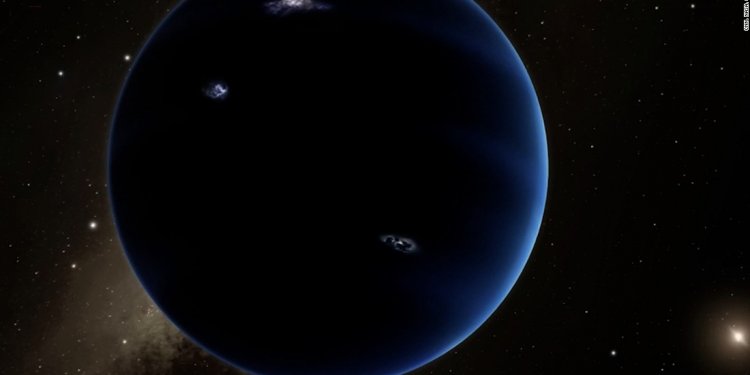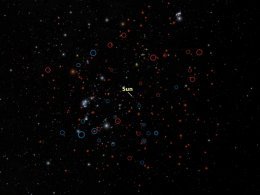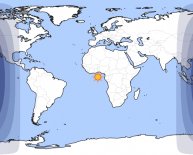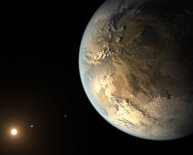
Earth around the Sun theory
 In a survey of the sky, WISE found more brown dwarfs farther from the sun than it did nearby. In this image of our astronomical back yard, shown from a the view of 30 light-years from the sun, brown dwarfs within 26 light-years from the sun are circled, with objects in blue having been previously identified, while red circles indicate new brown dwarfs revealed by WISE.
In a survey of the sky, WISE found more brown dwarfs farther from the sun than it did nearby. In this image of our astronomical back yard, shown from a the view of 30 light-years from the sun, brown dwarfs within 26 light-years from the sun are circled, with objects in blue having been previously identified, while red circles indicate new brown dwarfs revealed by WISE.
Nemesis is a theoretical dwarf star thought to be a companion to our sun. The theory was postulated to explain a perceived cycle of mass extinctions in Earth's history. Scientists speculated that such a star could affect the orbit of objects in the far outer solar system, sending them on a collision course with Earth.
Recent astronomical surveys, however, failed to find any evidence that such a star exists.
The argument for Nemesis
In the early 1980s, scientists noticed that extinctions on Earth seemed to fall in a cyclical pattern. Mass extinctions seem to occur more frequently every 27 million years. The long span of time caused them to turn to astronomical events for an explanation.
In 1984, Richard Muller of the University of California Berkley suggested that a red dwarf star 1.5 light-years away could be the cause of the mass extinctions. Later theories have suggested that Nemesis could be a brown or white dwarf, or a low-mass star only a few times as massive as Jupiter. All would cast dim light, making them difficult to spot.
Scientists speculated that Nemesis may affect the Oort cloud, which is made up of icy rocks surrounding the sun beyond the range of Pluto. Many of these chunks travel around the sun in a long-term, elliptical orbit. As they draw closer to the star, their ice begins to melt and stream behind them, making them recognizable as comets.
If Nemesis traveled through the Oort cloud every 27 million years, some argue, it could kick extra comets out of the sphere and send them hurling toward the inner solar system — and Earth. Impact rates would increase, and mass extinctions would be more common.
The Kuiper Belt, a disk of debris that lies inside of the solar system, also has a well-defined outer edge that could be sheared off by a companion star. Researchers have found other systems where a companion star seems to have affected the shape of the debris disks.
The dwarf planet Sedna lends further credence in the eyes of some to the existence of a companion star for the sun. With an orbit of up to 12, 000 years, the planet presents a puzzle to many. Scientists have suggested that a massive object such as a dim star could be responsible for keeping Sedna so far from the sun.
Though they look serene and silent from our vantage on Earth, stars are actually roiling balls of violent plasma. Test your stellar smarts with this quiz.
0 of 10 questions complete
Star Quiz: Test Your Stellar Smarts
Though they look serene and silent from our vantage on Earth, stars are actually roiling balls of violent plasma. Test your stellar smarts with this quiz.
0 of questions complete
A theory under fire
Though some scientists find the Nemesis theory plausible, others do not. The initial cyclical nature of mass extinctions is still under discussion. Studies of craters seem to indicate that such a pattern does not exist. Other studies of fossil records suggest that mass extinctions are more likely to happen around those peaks, though extinction events occur during other epochs.
In order to avoid significantly affecting the orbit of the planets, as well as to avoid observation, Nemesis must remain at a distance from the sun. But astronomers argue that such an orbit would be inherently unstable. Traveling so far out, Nemesis would be affected by other stars moving through the galaxy. The resulting orbit would not provide a steady kick to the Oort cloud but would be constantly changing.
Spotting the unseen
A solar companion may be hard to find, but it would still be visible by sensitive telescopes. Astronomers have scoured the sky using the Two Micron All Sky Survey (2MASS), which studied the sky over four years in three infrared wavelengths. The instrument discovered 173 brown dwarfs farther away than our solar system, but none near enough to be the infamous Nemesis.
NASA's Wide-field Infrared Survey Explorer completed its 1.25-year mission in February 2011, having discovered a number of brown dwarfs within 20 light-years. Again, none of these were located near the solar system.
(T)he Sun is not part of a binary star system. There has never been any evidence to suggest a companion. The idea has been disproved by several infrared sky surveys, most recently the WISE mission. If there were a brown dwarf companion, these sensitive infrared telescopes would have detected it.

















